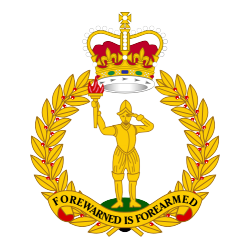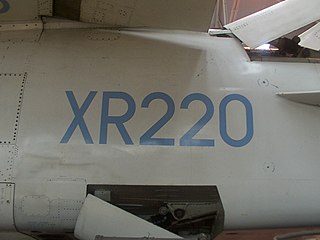
Aircraft spotting, or planespotting, is a hobby consisting of observing and tracking aircraft, which is usually accomplished by photography or videography. Besides monitoring aircraft, planespotting enthusiasts also record information regarding airports, air traffic control communications, airline routes, and more.

The de Havilland DH.82 Tiger Moth is a 1930s British biplane designed by Geoffrey de Havilland and built by the de Havilland Aircraft Company. It was operated by the Royal Air Force (RAF) and other operators as a primary trainer aircraft. In addition to the type's principal use for ab initio training, the Second World War had RAF Tiger Moths operating in other capacities, including maritime surveillance and defensive anti-invasion preparations; some aircraft were even outfitted to function as armed light bombers.

The Miles M.14 Magister is a two-seat monoplane basic trainer aircraft designed and built by the British aircraft manufacturer Miles Aircraft. It was affectionately known as the Maggie. It was authorised to perform aerobatics.

The Royal Aircraft Factory B.E.2 is a British single-engine tractor two-seat biplane, designed and developed at the Royal Aircraft Factory. Most of the roughly 3,500 built were constructed under contract by private companies, including established aircraft manufacturers and firms new to aircraft construction.

The Avro 504 is a single-engine biplane bomber made by the Avro aircraft company and under licence by others. Production during World War I totalled 8,970 and continued for almost 20 years, making it the most-produced aircraft of any kind that served in any military capacity during the First World War. More than 10,000 were built from 1913 until production ended in 1932.

The Bristol F.2 Fighter is a British First World War two-seat biplane fighter and reconnaissance aircraft developed by Frank Barnwell at the British and Colonial Aeroplane Company later known as the Bristol Aeroplane Company. It is often simply called the Bristol Fighter, "Brisfit" or "Biff".

The Fairey Aviation Company Fairey III was a family of British reconnaissance biplanes that enjoyed a very long production and service history in both landplane and seaplane variants. First flying on 14 September 1917, examples were still in use during the Second World War.

The Royal Aircraft Factory S.E.5 is a British biplane fighter aircraft of the First World War. It was developed at the Royal Aircraft Factory by a team consisting of Henry Folland, John Kenworthy and Major Frank Goodden. It was one of the fastest aircraft of the war, while being both stable and relatively manoeuvrable. According to aviation author Robert Jackson, the S.E.5 was: "the nimble fighter that has since been described as the 'Spitfire of World War One'".

The Royal Observer Corps (ROC) was a civil defence organisation intended for the visual detection, identification, tracking and reporting of aircraft over Great Britain. It operated in the United Kingdom between 29 October 1925 and 31 December 1995, when the Corps' civilian volunteers were stood down. Composed mainly of civilian spare-time volunteers, ROC personnel wore a Royal Air Force (RAF) style uniform and latterly came under the administrative control of RAF Strike Command and the operational control of the Home Office. Civilian volunteers were trained and administered by a small cadre of professional full-time officers under the command of the Commandant Royal Observer Corps; latterly a serving RAF Air Commodore.

The United Kingdom Warning and Monitoring Organisation (UKWMO) was a British civilian organisation operating to provide UK military and civilian authorities with data on nuclear explosions and forecasts of fallout across the country in the event of nuclear war.
Derek Wood was the author of Jane's World Aircraft Recognition Handbook. Wood was the editor of "Jane's" the publishers of a wide range of military handbooks and weekly defence newsletters until he retired in 1993.
The Aeroplane and Armament Experimental Establishment (A&AEE) was a research facility for British military aviation from 1918 to 1992. Established at Martlesham Heath, Suffolk, the unit moved in 1939 to Boscombe Down, Wiltshire, where its work continues following privatisation as part of the Qinetiq company.

The Parnall Panther was a British carrier-based, spotter and reconnaissance aircraft designed and developed by Parnall and Sons in the latter years of the First World War, continuing in service until 1926. A total of 150 Panthers were built by Bristol Aeroplane Company since after the end of the war, Parnall had stopped aircraft manufacture.

The Volunteer Air Observers Corps (VAOC) was an Australian air defence organisation of World War Two. The VAOC was formed in December 1941 to support the Royal Australian Air Force (RAAF) with its main roles of sighting and observing aircraft over Australia. The VAOC swiftly established thousands of Observation Posts (OP) across the country and provided information to the RAAF's regional air control posts.

United Kingdom military aircraft registration number, known as its serial number, or tail code is a specific aircraft registration scheme used to identify individual military aircraft in the United Kingdom (UK). All UK military aircraft are allocated and display a unique registration number. A unified registration number system, maintained initially by the Air Ministry (AM), and its successor the Air section of the Ministry of Defence, is used for aircraft operated by the Royal Air Force (RAF), Fleet Air Arm (FAA), and Army Air Corps (AAC). Military aircraft operated by government agencies and civilian contractors are also assigned registration numbers from this system.

The Commandant of the Royal Observer Corps (CROC) was the Royal Air Force commander of the Royal Observer Corps. All the holders of the post were RAF officers in the rank of Air Commodore, initially retired reserve officers then Auxiliary officers and, since the end of World War II, serving officers. The ROC was a uniformed civilian branch initially under the control of the Air Defence of Great Britain organization, then Fighter Command and latterly Strike Command. The Royal Observer Corps existed from 1925 until it was stood down in 1995. Most of the commandants, with only three exceptions, were qualified RAF pilots, two being air navigators and the other a General Duties (Ground) Supply Branch officer. If a Royal Observer Corps officer had ever held the appointment, they would have held the rank of Observer Commodore.
Air-Britain, traditionally sub-titled 'The International Association of Aviation Enthusiasts', is a non-profit aviation society founded in July 1948. As from 2015, it is constituted as a British charitable trust and book publisher.

The Cody IV monoplane was a single-engined monoplane designed and built by the American-born but British-based aviation pioneer Samuel Franklin Cody in 1912. It was intended for entry into the 1912 British Military Aeroplane Competition, but was wrecked in a crash before the start of the competition.

Aircraft Recognition, subtitled The Inter-Services Journal was a British Second World War magazine dedicated to the subject of aircraft recognition. Published monthly by the Ministry of Aircraft Production between September 1942 and September 1945, the target audience of the magazine was members of all three British Armed Services as well as members of the Royal Observer Corps.

In 1911 the British War Office announced their first Military Aeroplane Competition for aircraft to meet the requirements of the Air Battalion Royal Engineers. The formal requirements were published in December 1911. By the time the trials were held in August 1912, the Air Battalion had become the Military wing of the Royal Flying Corps (RFC). It was held at Larkhill on Salisbury Plain, and the competition was won by S. F. Cody with his Cody V biplane.



















